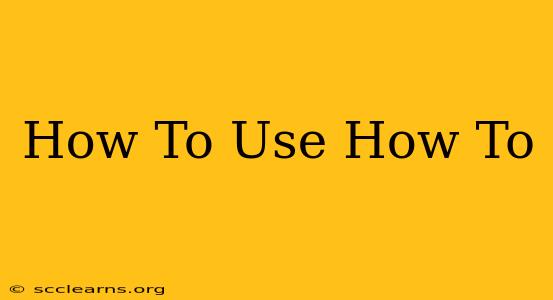So, you want to write a "how-to" guide? Excellent! "How-to" articles are incredibly popular because they provide valuable, actionable information. But simply stringing together instructions isn't enough to create a successful piece that ranks well in search engines and keeps readers engaged. This guide will show you how to use the "how-to" format to its full potential.
Understanding Your Audience and Keyword Research: The Foundation of a Great "How To"
Before you even start writing, you need to understand who you're writing for and what they're searching for.
Identifying Your Target Audience:
- Who are you trying to reach? Beginners? Experts? A specific demographic? Knowing your audience helps tailor your language, tone, and level of detail.
- What are their pain points? What problems are they trying to solve? Your "how-to" should directly address these issues.
- What are their existing knowledge levels? Don't assume prior knowledge. Explain concepts clearly and concisely.
Keyword Research: Finding the Right Search Terms:
Effective keyword research is crucial for SEO success. Use tools like Google Keyword Planner, Ahrefs, SEMrush, or even just Google's autocomplete function to find relevant keywords and long-tail keywords.
- Focus on long-tail keywords: These are more specific phrases, like "how to bake a sourdough bread with a Dutch oven" instead of just "how to bake bread." They attract more targeted traffic.
- Analyze competitor content: See what keywords your competitors are ranking for and how they're structuring their content.
- Use a variety of keywords: Incorporate your main keyword naturally throughout your title, headings, subheadings, and body text. Don't keyword stuff!
Structuring Your "How To" for Maximum Impact
A well-structured "how-to" guide is easy to follow and keeps readers engaged.
Compelling Headline and Introduction:
- Grab attention immediately: Your headline should clearly communicate the benefit of reading your article.
- Introduce the problem and solution: Briefly explain the problem your guide solves and what readers will learn.
Step-by-Step Instructions:
- Clear and concise steps: Each step should be easily understood and actionable.
- Use numbered lists: This makes the instructions easy to follow.
- Visual aids: Include images, videos, or illustrations to clarify complex steps. High-quality visuals significantly boost engagement.
Troubleshooting and FAQs:
- Address potential problems: Anticipate common challenges readers might face and provide solutions.
- Include an FAQ section: Answer frequently asked questions to further enhance understanding.
Optimizing for SEO: Getting Found by Search Engines
Beyond great content, you need to optimize your "how-to" for search engines.
On-Page SEO:
- Title Tag Optimization: Use your primary keyword in the title tag.
- Meta Description: Write a compelling meta description that accurately reflects your content and includes your target keyword.
- Header Tags (H1-H6): Use header tags to structure your content logically and incorporate keywords naturally.
- Image Optimization: Use descriptive file names and alt text for all images, including your primary keyword.
Off-Page SEO:
- Link Building: Promote your "how-to" guide on social media and other relevant websites to build backlinks.
- Social Media Promotion: Share your article on social media platforms to increase visibility.
Maintaining Reader Engagement: Beyond the Basics
- Use a conversational tone: Write in a friendly, approachable style.
- Break up text with visuals: Images, videos, and other visuals improve readability.
- Use strong calls to action: Encourage readers to leave comments, share the article, or visit other relevant pages on your website.
By following these steps, you can create highly effective "how-to" guides that rank well in search engines and provide real value to your readers. Remember, consistent effort and a focus on quality content are key to long-term success.

